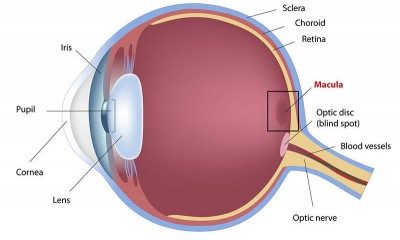Why Retinal Photos?
Patients often wonder why the Envision Eyecare team advises retinal photos.  A good question since, when it's not covered by insurance, there is a $39 fee associated with it. What's the value and why is it in the patient's best interest to "opt in?"The basics: The retina is the cellophane thick layer in the back of the eye composed of rods and cones that is responsible for sending light images to the brain for processing what we experience as vision. In other words, we don’t actually see with our eyes. They simply collect the light for one's brain, which then processes the information almost instantly, and voila: our priceless sense of sight. As you can imagine, the health and function of our retinas are crucial for accurate vision to take place. There are countless types of cancers, infections, inflammations and other degenerations that can damage our retinas and therefore reduce our sharpest, clearest vision.Now that we know how important retinal health is, why is it important to have your retina imaged? I often liken it to dental x-rays. My dentist takes x-rays of my teeth to document their appearance as a baseline. At later exams, he/she can refer back to these images to make critical medical decisions on behalf of my chompers. I only have 28 teeth to last for my entire life, so I will do any and everything to keep them healthy. (When I was a child, each night my dad would seriously joke, "only brush the ones you want to keep".)Well, we only get two eyes to last us a lifetime. I don't know about you, but I want all my years in this life to be years with sight. Retinal photos allow me to evaluate your retina the day of your exam and furthermore document its appearance for comparison at subsequent exams. I can tell if any changes in retinal appearance correspond with an active disease process. It may surprise you, but many eye diseases are painless and asymptomatic. Once the vision is lost, it is gone forever. Patients that have lost vision and have found me express that they would do anything I tell them to in order to enhance the vision that still remains.It never ceases to amaze me when, despite my advice from years of training and clinical experience, patients tell me retinal photos aren't necessary for them because, "I see fine" or "I don't need that test". But then again, it's only human nature to take for granted what is gifted to us every day. We open our eyes each morning with the expectation of seeing, but what if one day a person awoke and had lost vision? What if that vision loss could have been prevented with eye heath examinations and routine retinal imaging? Presented like this, yearly eye health exams with retinal photos make a lot of sense, right?So how do I remain confident we are doing right by our patients? What types of conditions have we uncovered that have made a difference in our patients’ lives with the assistance of this invaluable clinical tool? As I scroll through my mind of the retinal images that are saved on the Envision server, here is the short list. (In as few clinical terms possible):Swollen optic nerves—I sent this patient, who simply complained of blurry vision with computer use, directly to the E.R.. Turns out she had a tumor the size of a baseball in the back of her brain.Cancer—We detected a lesion called a choriodal osteoma last spring and promptly sent this patient to a retinal specialist for further evaluation. We've also detected melanomas and other cancers that affect the retina.Diabetic Retinopathy—Diabetes is the leading cause of blindness in the USA for people under the age of 55.Macular Degeneration—This is the leading cause of blindness in the USA
A good question since, when it's not covered by insurance, there is a $39 fee associated with it. What's the value and why is it in the patient's best interest to "opt in?"The basics: The retina is the cellophane thick layer in the back of the eye composed of rods and cones that is responsible for sending light images to the brain for processing what we experience as vision. In other words, we don’t actually see with our eyes. They simply collect the light for one's brain, which then processes the information almost instantly, and voila: our priceless sense of sight. As you can imagine, the health and function of our retinas are crucial for accurate vision to take place. There are countless types of cancers, infections, inflammations and other degenerations that can damage our retinas and therefore reduce our sharpest, clearest vision.Now that we know how important retinal health is, why is it important to have your retina imaged? I often liken it to dental x-rays. My dentist takes x-rays of my teeth to document their appearance as a baseline. At later exams, he/she can refer back to these images to make critical medical decisions on behalf of my chompers. I only have 28 teeth to last for my entire life, so I will do any and everything to keep them healthy. (When I was a child, each night my dad would seriously joke, "only brush the ones you want to keep".)Well, we only get two eyes to last us a lifetime. I don't know about you, but I want all my years in this life to be years with sight. Retinal photos allow me to evaluate your retina the day of your exam and furthermore document its appearance for comparison at subsequent exams. I can tell if any changes in retinal appearance correspond with an active disease process. It may surprise you, but many eye diseases are painless and asymptomatic. Once the vision is lost, it is gone forever. Patients that have lost vision and have found me express that they would do anything I tell them to in order to enhance the vision that still remains.It never ceases to amaze me when, despite my advice from years of training and clinical experience, patients tell me retinal photos aren't necessary for them because, "I see fine" or "I don't need that test". But then again, it's only human nature to take for granted what is gifted to us every day. We open our eyes each morning with the expectation of seeing, but what if one day a person awoke and had lost vision? What if that vision loss could have been prevented with eye heath examinations and routine retinal imaging? Presented like this, yearly eye health exams with retinal photos make a lot of sense, right?So how do I remain confident we are doing right by our patients? What types of conditions have we uncovered that have made a difference in our patients’ lives with the assistance of this invaluable clinical tool? As I scroll through my mind of the retinal images that are saved on the Envision server, here is the short list. (In as few clinical terms possible):Swollen optic nerves—I sent this patient, who simply complained of blurry vision with computer use, directly to the E.R.. Turns out she had a tumor the size of a baseball in the back of her brain.Cancer—We detected a lesion called a choriodal osteoma last spring and promptly sent this patient to a retinal specialist for further evaluation. We've also detected melanomas and other cancers that affect the retina.Diabetic Retinopathy—Diabetes is the leading cause of blindness in the USA for people under the age of 55.Macular Degeneration—This is the leading cause of blindness in the USA for people over the age of 55. There are 2 forms: Dry and Wet. Wet Macular degeneration (pictured on right) is the more aggressive form of the disease.Hypertensive Retinopathy—We routinely take a patient's blood pressure to compare with the retinal blood vessels. To date, we have sent one patient to the E.R. and a second patient directly to his primary care physician, who commented, "that Optometrist saved your life". That makes this guy feel all warm and fuzzy inside.Glaucoma—One specific case where my patient had just moved to AVL and had had an eye exam 8 months prior where the condition was not detected. Some eye diseases progress rapidly.Central Retinal Vein Occlusion—This patient had elevated blood sugar and blood pressure, which caused an occlusion of the main vein of the retina. He later got his blood sugar and pressure under control. The retinal specialist is still working with his eye to regain whatever visual acuity possible.The list goes on and on. This is why if I had it my way, every patient that walked through the front door would get retinal photos.I hope this helps explain why we are passionate about retinal photos. We do not take for granted the trust our patients place in us to care for their eyes and vision. It is our responsibility to advocate for your best sight now, and every year into the future!Dr. Larry Golson is an Eye Doctor in Western North Carolina
for people over the age of 55. There are 2 forms: Dry and Wet. Wet Macular degeneration (pictured on right) is the more aggressive form of the disease.Hypertensive Retinopathy—We routinely take a patient's blood pressure to compare with the retinal blood vessels. To date, we have sent one patient to the E.R. and a second patient directly to his primary care physician, who commented, "that Optometrist saved your life". That makes this guy feel all warm and fuzzy inside.Glaucoma—One specific case where my patient had just moved to AVL and had had an eye exam 8 months prior where the condition was not detected. Some eye diseases progress rapidly.Central Retinal Vein Occlusion—This patient had elevated blood sugar and blood pressure, which caused an occlusion of the main vein of the retina. He later got his blood sugar and pressure under control. The retinal specialist is still working with his eye to regain whatever visual acuity possible.The list goes on and on. This is why if I had it my way, every patient that walked through the front door would get retinal photos.I hope this helps explain why we are passionate about retinal photos. We do not take for granted the trust our patients place in us to care for their eyes and vision. It is our responsibility to advocate for your best sight now, and every year into the future!Dr. Larry Golson is an Eye Doctor in Western North Carolina





